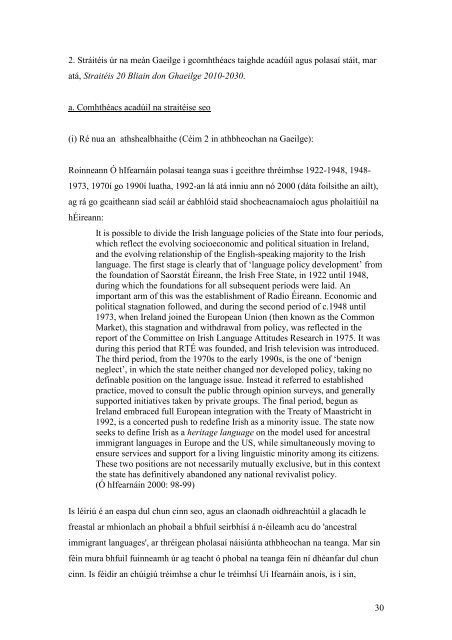Create successful ePaper yourself
Turn your PDF publications into a flip-book with our unique Google optimized e-Paper software.
2. Stráitéis úr na meán Gaeilge i gcomhthéacs taighde acadúil agus polasaí stáit, mar<br />
atá, Straitéis 20 Bliain don Ghaeilge 2010-2030.<br />
a. Comhthéacs acadúil na straitéise seo<br />
(i) Ré nua an athshealbhaithe (Céim 2 in athbheochan na Gaeilge):<br />
Roinneann Ó hIfearnáin polasaí teanga suas i gceithre thréimhse 1922-1948, 1948-<br />
1973, 1970í go 1990í luatha, 1992-an lá atá inniu ann nó 2000 (dáta foilsithe an ailt),<br />
ag rá go gcaitheann siad scáil ar éabhlóid staid shocheacnamaíoch agus pholaitíúil na<br />
hÉireann:<br />
It is possible to divide the Irish language policies of the State into four periods,<br />
which reflect the evolving socioeconomic and political situation in Ireland,<br />
and the evolving relationship of the English-speaking majority to the Irish<br />
language. The first stage is clearly that of ‘language policy development’ from<br />
the foundation of Saorstát Éireann, the Irish Free State, in 1922 until 1948,<br />
during which the foundations for all subsequent periods were laid. An<br />
important arm of this was the establishment of Radio Éireann. Economic and<br />
political stagnation followed, and during the second period of c.1948 until<br />
1973, when Ireland joined the European Union (then known as the Common<br />
Market), this stagnation and withdrawal from policy, was reflected in the<br />
report of the Committee on Irish Language Attitudes Research in 1975. It was<br />
during this period that RTÉ was founded, and Irish television was introduced.<br />
The third period, from the 1970s to the early 1990s, is the one of ‘benign<br />
neglect’, in which the state neither changed nor developed policy, taking no<br />
definable position on the language issue. Instead it referred to established<br />
practice, moved to consult the public through opinion surveys, and generally<br />
supported initiatives taken by private groups. The final period, begun as<br />
Ireland embraced full European integration with the Treaty of Maastricht in<br />
1992, is a concerted push to redefine Irish as a minority issue. The state now<br />
seeks to define Irish as a heritage language on the model used for ancestral<br />
immigrant languages in Europe and the US, while simultaneously moving to<br />
ensure services and support for a living linguistic minority among its citizens.<br />
These two positions are not necessarily mutually exclusive, but in this context<br />
the state has definitively abandoned any national revivalist policy.<br />
(Ó hIfearnáin 2000: 98-99)<br />
Is léiriú é an easpa dul chun cinn seo, agus an claonadh oidhreachtúil a glacadh le<br />
freastal ar mhionlach an phobail a bhfuil seirbhísí á n-éileamh acu do 'ancestral<br />
immigrant languages', ar thréigean pholasaí náisiúnta athbheochan na teanga. Mar sin<br />
féin mura bhfuil fuinneamh úr ag teacht ó phobal na teanga féin ní dhéanfar dul chun<br />
cinn. Is féidir an chúigiú tréimhse a chur le tréimhsí Uí Ifearnáin anois, is í sin,<br />
30


